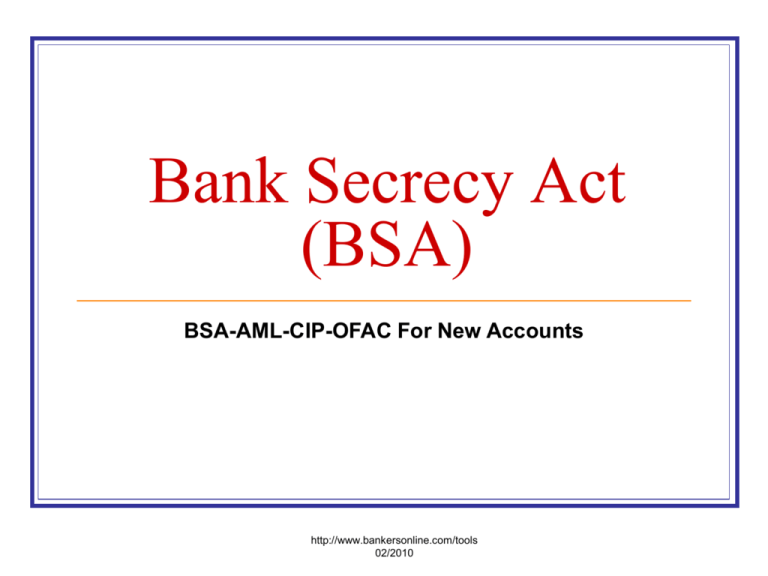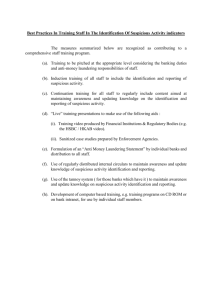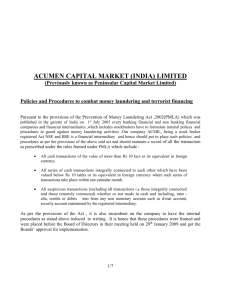BSA for New Accounts - PPT
advertisement

Bank Secrecy Act (BSA) BSA-AML-CIP-OFAC For New Accounts http://www.bankersonline.com/tools 02/2010 What is the BSA? The Bank Secrecy Act (BSA) requires all financial institutions, casinos, and certain other businesses to: Monitor customer behavior File reports on transactions that meet certain dollar amounts Maintain records of certain transactions The Currency Transaction Report (CTR), which records cash transactions that exceed $10,000. The Suspicious Activity Report (SAR), which records any known or suspected federal violation of federal law. The BSA aids law enforcement by uncovering criminal activities such as money laundering, drug trafficking, tax fraud, and possible terrorist financing. http://www.bankersonline.com/tools 02/2010 USA Patriot Act After September 11th, President Bush signed into law the Uniting and Strengthening America by Providing Appropriate Tools Required to Intercept and Obstruct Terrorism Act Provides additional tools to prevent, detect, and prosecute international money laundering and the financing of terrorism. http://www.bankersonline.com/tools 02/2010 Office of Foreign Assets Control OFAC is part of the US Treasury Dept and enforces economic and trade sanctions based on US foreign policy and national security goals against targeted foreign countries, terrorists, and international narcotics traffickers Parties subject to the OFAC sanctions are: Specially Designated Nationals Specially Designated Terrorists Specially Designated Narcotics Traffickers Blocked Persons Blocked Vessels OFAC laws require banks to identify any transactions and property subject to the economic sanctions Once identified, the asset must be blocked or the transaction may be rejected http://www.bankersonline.com/tools 02/2010 Customer Identification Program (CIP) Three basic rules Verify identity of customer opening account Maintain records for 5 years after account is closed Check government lists (OFAC) To verify identity, we must obtain six important pieces of information prior to opening an account: Name Date of birth Residential or business street address Numbers (US Tax ID # or foreign issued alien ID card #) Document (Place of Issuance, Number, Issue & Expiration Date) Occupation Notice displayed on each new account and loan officer desk explaining our customer identification program For every new business, the http://www.bankersonline.com/tools CSR completes a risk assessment form 02/2010 Customer Identification Program (CIP) The CIP rule applies to a “customer”. A customer is an individual, a corporation, partnership, a trust, an estate, or any other entity recognized as a legal person who opens a new account. TIP: Whoever owns the SSN/EIN is the customer! Definition of Existing A customer who was identified according to bank procedures prior to October 1, 2003. In verifying the identity of an existing customer, Bank employees will check the existing signature card and any supporting documents to establish that the customer’s identity has already been validated according to the Bank’s account opening procedures. If there are any discrepancies, Bank employees will perform CIP if the employee finds that vital information is missing. http://www.bankersonline.com/tools 02/2010 Customer Identification Program (CIP) Verify a Business: Arizona: http://starpas.azcc.gov/scripts/cgiip.exe/WService=wsbroker1/connect.p?app=namesreport.p California: http://kepler.sos.ca.gov/list.html Shasta County: http://www.co.shasta.ca.us/fbn/asp/fbninquiry.asp Sacramento County: http://www.efbn.saccounty.net/ Placer County: http://www.criis.com/placer/sfictitious.shtml Nevada: http://nvsos.gov/sosentitysearch/ Oregon: http://egov.sos.state.or.us/br/pkg_web_name_srch_inq.login Verify a Real Estate Agent or Broker: California: http://www2.dre.ca.gov/PublicASP/pplinfo.asp Nevada: http://red.prod.lookup.nv.gov/default.asp Verify a CPA: http://www.dca.ca.gov/cba/lookup.shtml Verify an Investment Company or Investor: http://www.sec.gov/edgar/searchedgar/companysearch.html http://www.bankersonline.com/tools 02/2010 Money Service Business (MSB) An MSB is defined as any person doing business, whether or not on a regular basis, in one or more of the capacities listed below: Cashes checks, money orders, travelers checks, and/or exchanges currency for more than $1,000 for any one customer on any day. (requires FinCEN registration) Charges more than $2.00 for these services. (requires Check Cashing Permit) Issues money orders, travelers checks, transmits wires, and/or collects utility payments as an Agent for a registered MSB. (requires Agent contract) (i.e. Western Union, CheckFreePay, Continental Express) The bank CANNOT do business with an Unregistered MSB. Should you believe you are opening an account for an MSB (typically a grocery store, gas station, or mini mart), Contact the BSA Officer immediately. http://www.bankersonline.com/tools 02/2010 What is a Large Currency Transaction? A large currency transaction consists of cash (bills or coin) greater than $10,000 or any single transaction or group of transactions made by or on behalf of one person or business that is greater than $10,000 in one business day. Before conducting any transaction in which a CTR is required, your institution must collect the following information for the individual, business, or entity that will benefit from the transaction (the beneficiary), and the individual conducting the transaction (the conductor): Beneficiary Conductor Name Name (including Doing Business As (DBA) Address SSN or EIN Date of Birth (for individuals) Occupation, Profession, or Nature of Business Proper Identification Address SSN Date of Birth Proper Identification http://www.bankersonline.com/tools 02/2010 What Is Money Laundering? Money Laundering is when illegal money is brought into the mainstream circulation. Launderers hide the source of these illegal funds by making a series of intricate transactions. The true source of the money is “washed away.” http://www.bankersonline.com/tools 02/2010 Suspicious Activity Report (SAR) A Suspicious Activity Report (SAR) must be filed on any known or suspected federal violation of law. Suspicious activity requires reporting if it involves at least $5,000 aggregate, and the institution knows or suspects that (for example): The funds are derived from illegal activities The funds are part of a plan to violate or evade any federal law or regulation The transaction is designed to evade other reporting requirements The transaction is not the sort in which the particular customer would normally be expected to engage, and the institution knows of no reasonable explanation for the transaction. http://www.bankersonline.com/tools 02/2010 Something Ain’t Right The first question you ask is if the activity is reasonable for that customer. If not, then that rises to the level of suspicious activity. Whether the action is ultimately a fraud is up to law enforcement to decide. Think Ghostbusters! “when there’s something strange in your neighborhood, who ya gonna call? If there's something weird and it don't look good, who you gonna call?” http://www.bankersonline.com/tools 02/2010 Detecting Suspicious Transactions Activity Not Consistent with Customer’s Business Unusual Characteristics or Activities A customer who often visits the safety deposit box area immediately before making cash deposits. Attempts to Avoid Reporting or Record Keeping Requirements A business owner who makes several deposits on the same day at different bank branches. A customer that asks the reporting amount for a CTR. Customer who Provides Insufficient or Suspicious Information A customer who has no record of past or present employment but makes frequent large transactions. If you believe your customer may be conducting Suspicious Activity … Notify your supervisor immediately. Do Not attempt to have ahttp://www.bankersonline.com/tools conversation with the customer before 02/2010 discussing with the BSA Officer. What is Structuring? Structuring is a common tactic used to launder money, specifically to place funds into the financial systems. A transaction is structured by breaking down a single sum of currency of more than $10,000 into smaller currency transactions. The transaction can consist of either deposits or withdrawals in amounts under $10,000. A person can act alone, or on behalf of another individual or business, in order to cause an institution to fail to file a CTR. Structuring Examples: After learning that a CTR will be filed, an individual attempts to reduce the transaction to fall below the reporting requirement of more than $10,000. An individual conducts multiple transactions over the course of several days in amounts less than $10,000. (e.g. $9,900 - $9,500 - $9,950) http://www.bankersonline.com/tools 02/2010 Other Types of Reportable Activity Bribery Check Fraud Check Kiting Computer Intrusion Counterfeit Check Counterfeit Credit/Debit Card Credit/Debit Card Fraud Embezzlement Mortgage Fraud False Statement Loan Fraud Misuse of Position Mysterious Disappearance Wire Transfer Fraud Tax Evasion Terrorist Financing Identity Theft http://www.bankersonline.com/tools 02/2010 But not our customers! In 2009, ABC BANK was contacted ## times by various Law Enforcement Agencies regarding ## different customers: List agencies here We’ve seized over $$$$$$ related to illegal activity! http://www.bankersonline.com/tools 02/2010 Penalties for Noncompliance Violations of BSA requirements may hold civil and / or criminal penalties, such as: Civil penalties of $1000 per day for each day of noncompliance. A penalty of $500 per violation of the recordkeeping requirements of the BSA. Willful violations may cause civil penalties in an amount equivalent to that of the transaction or $25,000, whichever is greater. If a required CTR is not filed within 15 days, a $10,000-per-day civil penalty may be imposed until it is filed. Continued noncompliance can result in the issuance of a “Cease & Desist” order from the FDIC. Any individual who willfully violates the structuring provisions may be fined $250,000 and/or imprisoned for five (5) years. Any individual who willfully violates the structuring provisions while violating another federal law, may be fined $500,000 or imprisoned for ten (10) years. http://www.bankersonline.com/tools 02/2010 Penalties for Noncompliance It is extremely important for all employees to know that it is not necessarily the bank that will suffer the penalty for non-compliance, but it could actually be the employee paying the fine and going to jail. Please do not compromise your position at the bank by ignoring these regulations. http://www.bankersonline.com/tools 02/2010 C’mon – no one has been fined ... ...Right? 4/20/09 - Doha Bank New York 01/02/09 - E*Trade CD & CMP $1 Million. 9/14/2007 - Union Bank of California Cease & Desist (CD) Note: This bank was closed by Texas Department of Banking on 12/12/08 07/30/08 - E*Trade CMP $1 Million. 10/16/08 - Sanderson State Bank $10 Million Civil Money Penalty (CMP) CMP $10 million Forfeiture. $21.6 million 8/3/2007 - American Express C&D order CMP $20 million (bank) CMP $5 million (company) Forfeiture. $55 million (bank) http://www.bankersonline.com/tools 02/2010 BANKS Family Bank and Trust Company (FBTC), an FDIC-insured non-member bank located in Palos Hills, Illinois, entered into a pleabargain agreement announced on 10/26/09 by the U.S. Attorney for the Northern District of Illinois. The bank agreed to plead guilty to federal criminal charges that it conspired with its former CEO and others to fail to file multiple CTRs involving deposits totaling more than $800,000. In its plea agreement, the bank agreed with the government to ask a judge to impose probation and a forfeiture of $800,000. 10/26/2009 - Family B&T - Forfeiture 08/05/2009 - First Standard Bank - C&D 08/04/2009 - Heritage Bank of North Florida - C&D 04/20/2009 - Doha Bank - CMP 04/02/2009 - Rocky Mountain B&T - C&D 02/24/2009 - Bank of Westminster - C&D 02/17/2009 - Directors of Sykesville FSA - CMPs 02/12/2009 - Upstate National Bank - C&D 02/12/2009 - University Bank - C&D 01/29/2009 - First Vietnamese American Bank - C&D 01/02/2009 - E*Trade Clearing LLC et al - Fine 12/03/2008 - West Suburban Bank - C&D 11/13/2008 - Mountain Commerce Bank - C&D 11/07/2008 - Dresdner Bank AG - C&D 11/03/2008 - Blue Ridge Savings Bank, Inc. - C&D 10/27/2008 - Polk County Bank - C&D 10/24/2008 - Eastern National Bank - CMP 10/17/2008 - Fort Davis State Bank - C&D 10/16/2008 - Sanderson State Bank - C&D 10/07/2008 - Omni National Bank - C&D 10/02/2008 - Kenney Bank and Trust - C&D 10/02/2008 - The Bank of Harlan - C&D 09/25/2008 - First Asian Bank - C&D FBTC was closely held by its former 09/15/2008 - Citizens Community Bank - C&D president, Marvin Siensa, now deceased. 09/09/2008 - Intercredit Bank, N.A. - C&D 08/27/2008 - Mizrahi Tefahot Bank, Ltd. - C&D The charges allege that Siensa and others 08/21/2008 - Chestatee State Bank - C&D 07/30/2008 - E*Trade Clearing LLC et al - C&D & CMP caused the bank to fail to file CTRs on 07/09/2008 - T Bank, N.A. - C&D multiple cash deposits, and to use nominee 06/04/2008 - Eastern National Bank - C&D 04/30/2008 - Sun Security Bank - C&D accounts to disguise the nature of the 04/22/2008 - United Bank for Africa, PLC - CMP 04/14/2008 - El Noa Noa - CMP deposits, which were largely the proceeds of 03/14/2008 - Independence Bank - C&D illegal activity, allegedly international 03/10/2008 - First Regional Bank - C&D 02/29/2008 - United Bank for Africa, PLC - C&D trafficking in pseudoephedrine, a key 02/26/2008 - Wallis State Bank - C&D 02/19/2008 - Doral Bank - C&D ingredient in the manufacture of 01/24/2008 - Sigue Corporation and Sigue, LLC - CMP methamphetamine. 12/19/2007 - The State Bank of Lebo C&D http://www.bankersonline.com/tool 12/03/2007 - The Citizens Bank of Weir, Kansas - C&D s 02/2010 10/30/2007 - Pan American Bank - C&D Your Responsibility Customer Service Representatives are required to know their customers and detect unusual/suspicious activity. Since CSRs are on the frontline, working closely with customers, they should be able to supply information to determine the extent of activity or provide explanations that would differentiate a suspicious activity from a non-suspicious activity. Complete the required forms at account opening to determine expected account activity/services All sections of the Risk Assessment Form are required and not optional. Be aware of the Bank’s designated Medium and High Risk customers Follow up with the customer in a timely manner for any required documentation requested and for renewed customer licensing, permits, etc. Report any suspicious activity to the BSA Officer. http://www.bankersonline.com/tools 02/2010 The Fine Print It is the policy of the Bank that all requirements of the Bank Secrecy Act are to be complied with. Willful failure to do so will result in immediate suspension, without pay, or termination. Employees who observe incidents of suspected violations, or failure to report transactions involving customers or fellow employees, are obligated to report such incidents to Risk Management or the Bank Secrecy Act (BSA) Officer. If the employee does not do so, they could be subject to disciplinary action, up to and including termination, and criminal prosecution. No employee shall be disciplined for properly reporting suspicious activity. http://www.bankersonline.com/tools 02/2010 1. *WHO (Suspect Name) *Tax ID/EIN *Birth Date *Profession *Physical Address *DL/ID # *Phone # 2. *What category does this report belong in? * indicates “most common” Computer Intrusion Credit Card Fraud * Kiting * Lottery Scheme Mysterious Disappearance * Tax Evasion Wire Fraud * Counterfeit Check ID Theft Loan Fraud * Money Laundering * Structuring Terrorist Activity Other 3. Account #’s Involved & Date Opened: 4. *Explain The Activity In Detail (WHAT and HOW): 5. *WHERE Did The Activity Take Place? (Include All Locations Involved): 6. *Explain WHY You Think This Activity Is Suspicious. (For Help Please Refer To The Information Provided On This Form). 7. *WHEN Did The Activity Occur?: From: Through: 8. List Any Other Individuals Involved: 9. *Branch Preparing Report: 10. *Report Prepared By: 11. *Approved By: (print name) 12. *Attach a copy of the signature card(s). 13. *Attach any supporting documentation. Date: Date: (approval signature) http://www.bankersonline.com/tool s 02/2010






